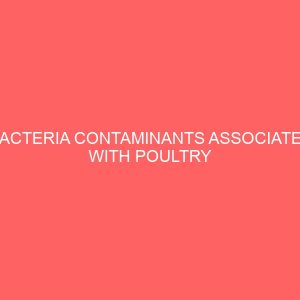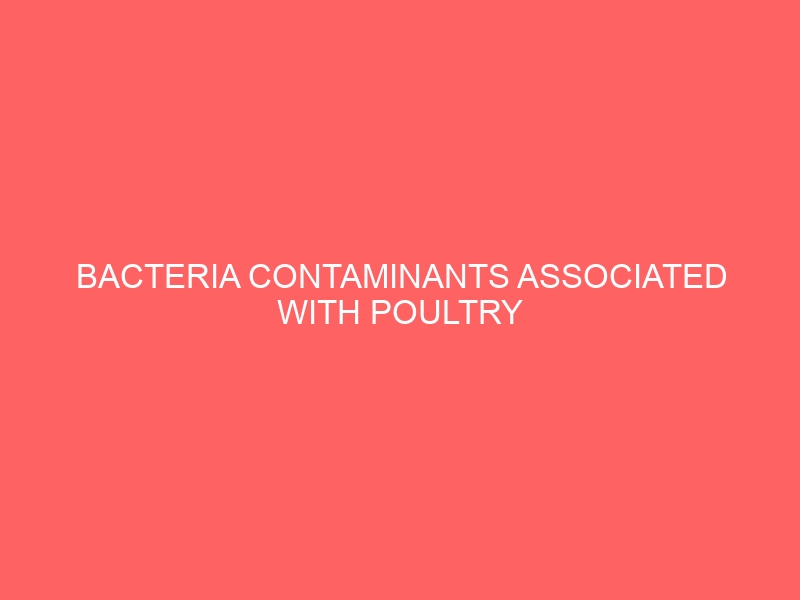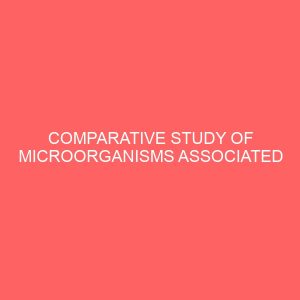Description
Bacteria contaminants associated with poultry feeds.
ABSTRACT
The bacteria contamination associated with poultry feeds from three different companies (vital, Guinea, and Top) were studied using streak plate techniques. The culture media used were nutrient agar and MacConkey agar. The aim/Objective of the study is. To ascertain the microbial safety of poultry feeds, to identify the bacterial types and to determine the microbial load of poultry feed. The microbial mean count was highest in vital feed as 1700 per ml followed by Guinea feed having mean count of 1490 per ml and least microbial mean count was got in top feed. Having 1070 per ml. The study revealed Staphylococcusaureus as the most predominant bacteria organism. Followed bySalmonella typhi, The next bacterial organism isolated wasBacillus cereus with and the least was Pseudomonas aeruginus. Also vital feed has the highest isolation of Staphylococcusaureus. The result showed that the poultry feeds in general had bacterial contamination.
But the microbial load was minimal increasing with decrease in acidity.
CHAPTER ONE:
1.0 INTRODUCTION
Poultry are collection of birds raised domestically for meat, egg and feathers, chickens, clucks, turkeys and geese are fowl and squabs are chiefly of local interest. These birds are source of income and food to the rarer. In the past, only hens that could no longer produce eggs were killed and sold for meat but by the mid – 20th century, meat production had outstripped egg. Production as a specialized industry (Barnes, K. 1993)
Today, poultry production in the country is increasing at a tremendous rate and yet cannot meet the demand because of population growth and the awareness created by the campaigns for the need of animal protein in the diet
There are different types of feeds given to poultry birds depending on the purpose, these different types are the breeders, starters, growers and layers feeds. The percentage of each ingredient in the feed varies depending on the type of feed. The ingredient includes ground yellow corn, ground oats.
Poultry have been found to be susceptible to infection due to certain microorganisms and man may be secondarily infected through heavy contaminated food such as poultry meat and eggs. Microorganisms that contaminate feed include,Enterobacter, Escherichia coli, Proteus, Pseudomonas, Staphylococcus, Salmonella, Shigella, Probidence, (Leonard, 1981).
1.6 OBJECTIVE OF STUDY
The objective of this study is to ascertain the microbial safety of poultry feeds production by companies (Vital, Guinea, and Top).
1.7 AIMS OF STUDY
To isolate bacteria that contaminant poultry feeds.
1.8 STATEMENT OF PROBLEM
Poultry feed is known to contain Salmonella and other microorganisms. ( Lapidot, 1990). It is therefore pertinent to carry out microbiological examination of commercially prepared poultry feeds to ascertain their safety to livestock.
1.9 LIMITATION OF THE STUDY
This work is limited to bacteria contaminates associated with poultry feeds from three different companies (Top, Guinea, and Vital).
1.10SIGNIFICANCE OF STUDY
At the end of the project work, the results will be a guide to the microbiological safety or otherwise of the commercially prepared poultry feeds.
CHAPTER TWO:
2.0 LITERATURE REVIEW
Among raw food items of animal origin, poultry meat and poultry meat products are considered to be some of the most contaminated products offered to the consumer. (Mead, 1993) This is due to the relatively high contamination with various food-borne infection agents present on and in the product. More than 27 different species of bacteria have been isolated from normal, ready to cook, poultry meat a large number of publications incriminate poultry as origin of food-borne infection out-breaks.
Modern production facilities for poultry tend to be large and intensive. A very large number of birds are maintained in each production unit. Under these conditions, it is nearly impossible to present the spread of a microorganism (such as Salmonella, Listeria, and Campylobacter) are aimed, inter-alias, towards prevention of the infection or colonization of the birds on the farm by various means of inhibiliting possible entrances of disease producing agents into the farm. High priority is given to decontamination of poultry feed, since all means employed to prevent infection will fail unless a supply of decontaminated feed is ensured.
The role of animal feed as a vector of pathogenic microorganisms, in particular Salmonella has been well documented in the literature of the last decades, (Lapidot 1998). Feed ingredients of animals origin, such as fish meal, meat and bone meats, slaughter ofals and feather meals are reported to be usually contaminated. However, ingredients of plant origin, such as oil-seed lake meals, are also reported to be contaminated, albeit at a relatively lower frequency.








Reviews
There are no reviews yet.